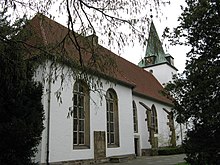Hille (locality)
|
Hille
municipality Hille
|
|
|---|---|
| Coordinates: 52 ° 20 ′ 10 ″ N , 8 ° 44 ′ 39 ″ E | |
| Height : | 55 m above sea level NN |
| Area : | 41.88 km² |
| Residents : | 4069 (Dec. 31, 2002) |
| Population density : | 97 inhabitants / km² |
| Incorporation : | 1st January 1973 |
| Postal code : | 32479 |
| Area code : | 05703 |
|
Location of Hille in Hille
|
|
Hille is a village in the municipality of the same name in the Minden-Lübbecke district in East Westphalia-Lippe .
It is located north of the Mittelland Canal and the Wiehengebirge and south of the Minden forest. To the east, Hille-Dorf borders the districts of Südhemmern , Nordhemmern and Holzhausen II and the Friedewalde district of the city of Petershagen , to the north to the district of Nienburg in Lower Saxony , to the west to the cities of Espelkamp and Lübbecke and to the south to the districts of Eickhorst and Unterlübbe . The village of Hille covers around 40 percent of the area of the entire municipality of Hille. In addition to the village center itself, most of the unpopulated or very sparsely populated areas belong to this district, such as the Hiller shares in Großem Torfmoor and Mindener Wald . However , the village of Hille has no part in the densely populated Lübbecker Loessland . This explains why the eponymous and by far most populous town and the administrative center of the municipality Hille with 97 inhabitants / km² has by far the lowest population density of all Hiller districts.
history
Hille is first mentioned in a document in 1140.
Until the municipal reorganization on January 1, 1973, Hille was an independent municipality with a total area of around 41.88 km² and 3767 inhabitants. and belonged to the office of Hartum in the Minden district . On December 31, 2002, 4069 residents lived here. In terms of area, Hille was by far the largest municipality in the Minden district.
Mayor
The population of Hille-Dorf has been represented to the council and administration of the Hille community since 1973 by a local mayor who is elected by the Hille community council on the basis of the election results. Herbert Heuer is currently (2008) mayor.
sons and daughters of the town
- Friedrich Schonhofen (1921–1984) was a German politician
Attractions
Windmill Hille "Auf der Höchte"
The Erdholländer was built in 1733. The lower third of the bulbous-conical mill tower was built from broken slate stones and above it from field fire stones, making it the second mill next to a dismantled post mill in town. Today it is plastered on the weather side. Until 1951 the mill was operated with wings, then one wing broke off in a storm and the mill was driven by a motor located next to the building. Until 1956 a gear part on the motor gear broke and the mill operation was completely stopped. After the restoration, the mill has windy "right-turning" sail blades again, a specialty in windmill construction, as otherwise almost all blades turn the other way round. As well as a compass rose system with an additional "pull wheel".
With the mill, Hille is part of the Westphalian Mill Road and the Mill Route .
Former Meyer distillery
The historic distillery of the former Meyer grain distillery, which was founded in 1721, was restored from 1995 to 2002. In 1995 the distillery building with boiler house and chimney was placed under monument protection. As far as the technical equipment is concerned, the distillery museum is unique in East Westphalia-Lippe . There is a stork's nest on the chimney, which has been occupied regularly since 2003.
Reimler's court
In the middle of the village is an old aristocratic court, which is known today as "Reimler's Court", but also - according to the inscription on the gatehouse - as " von Oeynhausen'scher Hof". The farm belonged to the couple from Oeynhausen / Pohlmann around 1700. After that it changed hands a few times until it was bought in 1882 by an American returnees named Reimler. Formerly completely surrounded by a wide moat, today only Reimler's pond exists, where many Hiller children have learned to ice-skate or slide-skate.
Also worth seeing is the Protestant parish church in Hille from 1523.
Individual evidence
- ↑ Martin Bünermann, Heinz Köstering: The communities and districts after the municipal territorial reform in North Rhine-Westphalia . Deutscher Gemeindeverlag, Cologne 1975, ISBN 3-555-30092-X .
Web links
- Hille community
- Hille (locality) in the Westphalia Cultural Atlas






